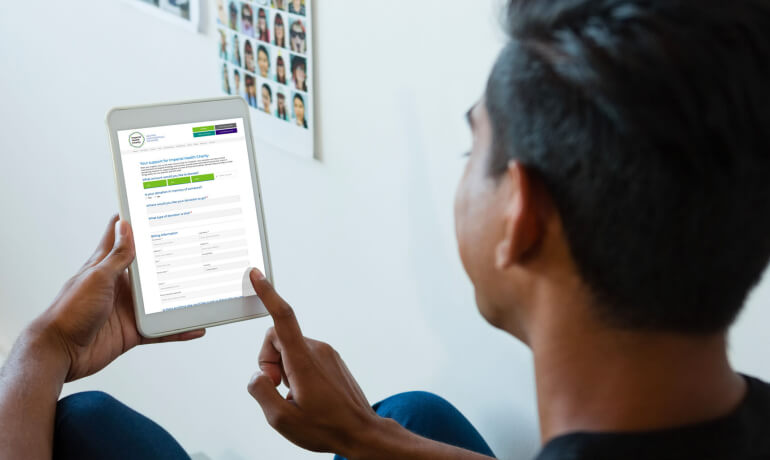What's in this article
Charities are in increasing numbers realising the benefits that a well functional website can bring to a good cause. Websites can help to increase donations, inspire volunteers and grow the awareness of your mission. However, there are some legal requirements for charity websites in the UK that must be adhered to. This helpful guide sets out everything you need to know about creating a charity website in 2023.
What your charity website will need to include:
As of 2023, these are the requirements that your charity website will need to include to ensure full compliance:
-
Name of the company or charity
-
Registered address
-
The part of the UK in which the company or charity is registered
-
Registered charity number
-
VAT number, if applicable
In addition, you need to be compliant with the Data Protection Act 1998 and The GDPR rules apply even for charities, so you must research those and take appropriate steps to ensure compliance. You must also register with the ICO and pay the appropriate data protection fee (unless you are exempt).
How to get the best out of a website for your charity
Set your budget and timeline for the project
In order to properly manage your budget and ensure that your time and resources are used efficiently, you must be clear and open regarding your budget in your communication with your team and the web design agency. This will maximise your chances of delivering a successful and realistic project. Everyone in the team will share a common understanding of each of their goals for the project and what is expected of them. Your web agency can also tailor their suggestions and solutions to fit your budget, ensuring the optimal result for your investment.
Establishing a timeframe is essential for the creation of a charity website since it gives the project a clear plan with actionable deadlines. The projected timeline will be a collaborative project between the charity and the web designer, to ensure that it suits both parties schedules. As part of the timeline, include important details about the allocation of tasks at each stage so that the project can develop without unnecessary delays.
Project management tools such as “Invision Freehand” can be crucial to helping you and your team stay on schedule and on task. Due to its collaborative whiteboarding features, InVision Freehand software is a great tool for website design. These features allow your designers and other team members to generate ideas, sketch wireframes, and provide feedback in real-time, promoting productive and imaginative web development processes. This creates a fantastic environment for ideas to grow and flourish for your website.
When considering your budget for your website creation, you might also need to consider other related costs such as:
Content Creation
One common misconception is that a new website build will include new copywriting as standard. This is often not the case. Whilst many web agencies will work closely with expert copywriters or might even have in-house capabilities to provide content for you, these costs are often separate from a standard web design quote.
SEO and Digital Marketing Budget
“Build it and they will come” is sadly not a phrase that is too applicable for charity websites. To ensure you make the most of your new website, think about how you will promote the website across the search engines and social media after the new site goes live.
By carefully considering and budgeting for these various aspects, your charity can create a website that effectively supports your mission and engages your audience while managing these timelines and costs efficiently.
Write for Charity: How to write effectively for your charity's marketing, publications and website (Charity Writing and Media Skills)
Write for Charity is your easy-to-use guide to creating compelling copy for your charity’s publications and online presence. Divided into simple-to-follow tips and advice, the emphasis is on small changes you can make to your writing that will generate more interest, more impact and more income for your charity. It covers how to write for your organisation’s newsletters and magazines, your marketing materials, your annual review and reports, your website and social media. Write for Charity can be read from cover to cover, or simple dipped into for expert advice on a subject of interest or weakness. Whether you work with a small community organisation or a national charity brand, you’ll quickly find your charity’s material is easier to put together, more powerful and more engaging. Vitally, you’ll find your words become more effective at getting readers to do what you want them to do.
Buy on AmazonIf you click this link and buy, we earn a commission at no additional cost to you.
Consider your audiences and their user journey
Designing a website for a charity requires taking into account your audience and their experiences in order to effectively engage and inspire visitors, encouraging their support for and leading them to volunteer in your charity cause. An effective charity website should give clear guidance as to “how?” or “why?” your volunteers should help your cause.
Many charities have benefited from considering a five stage customer journey:
- Awareness
- Consideration
- Decision
- Retention
- Advocacy
In the context of a charity website, this framework can be useful when deciding where one page should lead to the next. The journey and associated calls to action should differ between whether the visitor is discovering your charity for the first time, or is a repeat supporter of your good cause.
What are the objectives of your charity?
When designing your charity website, consider these three primary goals to maximise the number of donors and volunteers who will contribute:
Who do you want to help?
Identifying your target demographic before you begin the website design and build is essential because it enables you to customise your content to appeal to the individuals you want to help, maximising your engagement.
How do you want to help your charity cause?
When creating a charity website it is essential to explain how your organisation hopes to have a beneficial influence. This explanation should be visually displayed in an engaging manner that is easy to understand and digest. This will not only help your website visitors to learn about your goals but also motivates them to support your cause.
How will you execute your charity’s vision?
It is essential to outline your plan for carrying out your organisation's objective since it promotes openness, fosters confidence, and reassures potential donors that their donations will be used wisely to make a real difference. Testimonials and real-world examples are excellent ways of showing social proof of the societal good that your charity is able to deliver.

Review your CRM integrate it with your new website
Customer relationship management tools, known as CRMs, are a regular feature for larger charities with a sizeable list of supporters and members. Managing large databases can prove to be a troublesome and time consuming process for charities, especially when adding or updating information.
One method that can help charities to save time on the administration process is to integrate your website with your CRM. This will save time by cutting down on repetitive tasks such as copying information from one platform to the other. One integration feature that is used regularly is for new financial donors to be added automatically into the subscriber database that receives regular email newsletters about the good work the charity is undertaking.
If your current CRM does not provide an integration feature, usually in the form of an API that your web developers can use, it may be worth considering moving towards a CRM that does offer this capability. Whilst it might seem like a painful prospect in the short term, it may help to free up more of your team’s time to focus on the more important aspects of running your charity later down the line.
Simple, intuitive navigation
Use your customers' freedom of choice to your advantage by providing them with straightforward, helpful headlines on your website so they may choose how they want to support your cause without feeling compelled to do so (particularly when donating money). Long-term, this also results in more sincere volunteers who are more eager to support your nonprofit rather than those who feel harangued into supporting.
When drafting written instructions, it's crucial to bear in mind that each step should be brief and appropriately spaced out. You might even wish to include online process screenshots with obvious arrows or highlights to direct your donors.
Your website's click count must be kept to a low in order to enhance user experience and guarantee that visitors can quickly get the information they need. One approach to accomplish this is by having frequent but brief headers, which will allow your customers to explore your website without getting lost and being too much of a headspin! Walls of text in long paragraphs can be off-putting and difficult to digest.
Feature your mission statement
Featuring a mission statement on your website is vital to communicate the main principles of your charity to your target audience. This will help them feel more at ease and encourage them to participate in its operations. The purpose, values, scope, goals and the impact that will result from their contributions are all examples of specifics that are often found in mission statements for charities in the UK.
Build trust and communicate your work
Gaining your supporters’ trust is essential if you want them to donate to your cause. They want to be able to have confidence that their contributions or other voluntary actions will be put to good use. Acquiring this trust will depend on your ability to reassure them of this:
-
Linking to resources and blogs
Your charity website will be more credible if you link to other trustworthy blogs and resources. This will show visitors who are looking for reliable information that your organisation is knowledgeable and connected in the industry.
-
Showing your team
It is simple to establish a rapport with your clients by introducing them to the members of your team; this demonstrates your openness and fosters closer bonds among your employees, trustees and volunteers.
-
Content from your events and activities
Displaying content such as images from past events or video testimonials from people that you have supported helps to demonstrate the benefits of the contributions and volunteering that your charity receives.
Take monthly donations to build up your revenue
If your supporters are looking to financially donate to your charity regularly, you need to ensure you offer the capabilities for them to do so. Retaining financial supporters can prove to be more financially rewarding for your charity than prioritising new fundraising activities. One way to achieve this is to offer direct debit options for regular donations, rather than just having one-off donation options on your website. If your CRM has been integrated with your website, then supporters who sign up for monthly recurring payments can be added to a specific email database group to ensure that they receive regular updates on your good work. This will help to maximise retention and ensure that they remain long term supporters.
Create awareness of your charity with social media
One of the fastest-growing methods for a charity to establish a presence online is through regular and consistent utilisation of social media. Social media can be used to clearly communicate your objective to anybody who visits the page, as well as highlighting your everyday events.
In order to effectively spread their message and engage supporters, the social media services often used by charities include content creation, post scheduling, community management, analytics and reporting, paid advertising, strategy development, audience growth, competitor analysis, and platform management.
Keep personal data secure
The correct and proper handling of personal data is of utmost importance, especially for charitable organisations. Firstly, you must register with the "Information Commissioner's Office" (ICO), a regulatory body in the UK charged with defending information rights, promoting data privacy, and ensuring adherence to data protection laws, including the General Data Protection Regulation (GDPR). This must be completed before you can even begin to handle personal data as a charity.
Put simply, GDPR prioritises putting data security first, respecting people's right to privacy, and working with authorities as needed. The full list of its regulations can be found at UK General Data Protection Regulation (UK)
Personal data must be deleted after a predetermined amount of time to protect user privacy, avoid security threats, preserve data accuracy, and adhere to legal standards while lowering operational expenses and ethical dilemmas.
Create a highly accessible, excellent User Experience (UX), on any device
First impressions count, even for your charity website. You need to consider your user experience, especially how it initially appears, especially to users with accessibility requirements. Design considerations such as ensuring the site has a clear contrast, suitable font sizes, and the use of semantic code make it possible for users with a range of visual impairments to navigate your website easily and make its content simpler to understand.
If you lack knowledge in this area, you might think about hiring a professional to build your website. This will increase the content's presentation value. The speed at which your content will load on the various pages of the website is another essential aspect that you should take into account. This is because website visitors tend to abandon slow-loading websites for the simple reason that it is frustrating and looks unprofessional. Make sure your website is entirely responsive across all platforms, including smartphones, laptops, and computers. It should be able to adjust its font sizes, image sizes, navigation menu, and other elements to fit the device being used.
A platform that allows you to grow
A website build is hardly ever a static creation; you need a platform that allows you to maintain, edit and improve as your charity continues to grow. In order to consistently convey a sense of professionalism throughout your content, it would be important to consider training your staff on how to use the software and in the methods for creating various types of contents for each aspect of the website. You may even want to assign different jobs surrounding the website to those with accommodating skill levels. Platforms such as Concrete CMS offer intuitive and customisable options for website editors to update and change content without needing the help of their web developer.
When trying to expand your website, content marketing will be one of your best allies. It takes into account factors like content creation, content distribution, and even SEO marketing to increase engagement and optimise your content for search engines, which makes it more visible to donors.
Consider a professional copywriter
Employing a professional copywriter who can write with a consistent voice across all of your organisation's channels is essential for your charity. It will be simpler to create relevant material for your target audience if they understand the mission and history of your nonprofit organisation.
Your expert copywriter should focus heavily on SEO (Search Engine Optimisation), which will help you rank higher on search engines like Google, Bing, and Yahoo, among others. They will help with SEO tasks including keyword analysis, backlinking to your website, and the on-page contents of your website.
Clear CTA's (Calls to Action)
Contemplate offering a prominent "donate" button, include various payment options to reach a larger audience, and prompt acknowledgement messages for any gifts to provide your donors a sense of immediate fulfilment for supporting your charitable organisation. This may improve the likelihood of them repeating these donations in the future by ensuring that they know how appreciative your charity is for the support.
Clear, simple donation forms
It is essential for a charity website to simplify donation forms by keeping them brief, offering a range of payment options and by providing clear error warnings. A simple and quick donation process makes sure that potential donors aren't put off by complexity, increasing the likelihood that they'll finish their contributions. Users are guided through any problems they run into via clear error notifications, which minimises frustration and abandonment. By providing a range of payment choices, you can accommodate different donor preferences and make it simple for people to donate to your cause, which will ultimately boost donations.
Promote your content
Remember, content is king when it comes to promoting a successful charity website. By strategically promoting your content it increases your audience, develops trust, and motivates your fans. One popular way to promote your content is to focus on content collaborations, such as with recipients of your charitable work or with partners who help you to provide your goods or services.
What's next?
For many years now, we have specialised in websites for charities, proudly building high performing sites for the likes of St George's Hospital Charity and Imperial Health Charity. We love helping charities with their digital challenges and are not only are we well versed in the legal requirements of charity websites, we are also experienced building websites that help drive donations and increase volunteer sign ups. To get started, book a call with one of our friendly team members via our contact page to discuss how we can help to grow your charities online presence.
Join the discussion
Want to have your say on this topic? Start by posting your comment below...
Can we help?
We are a digital agency, specialising in web design, development, hosting and digital marketing. If you need help with anything, feel free to reach out...
Related Articles
What do you need on a good charity website?
21 November 2023
Maximising charity revenue: The power of monthly donations
22 September 2023
Keep up to date





